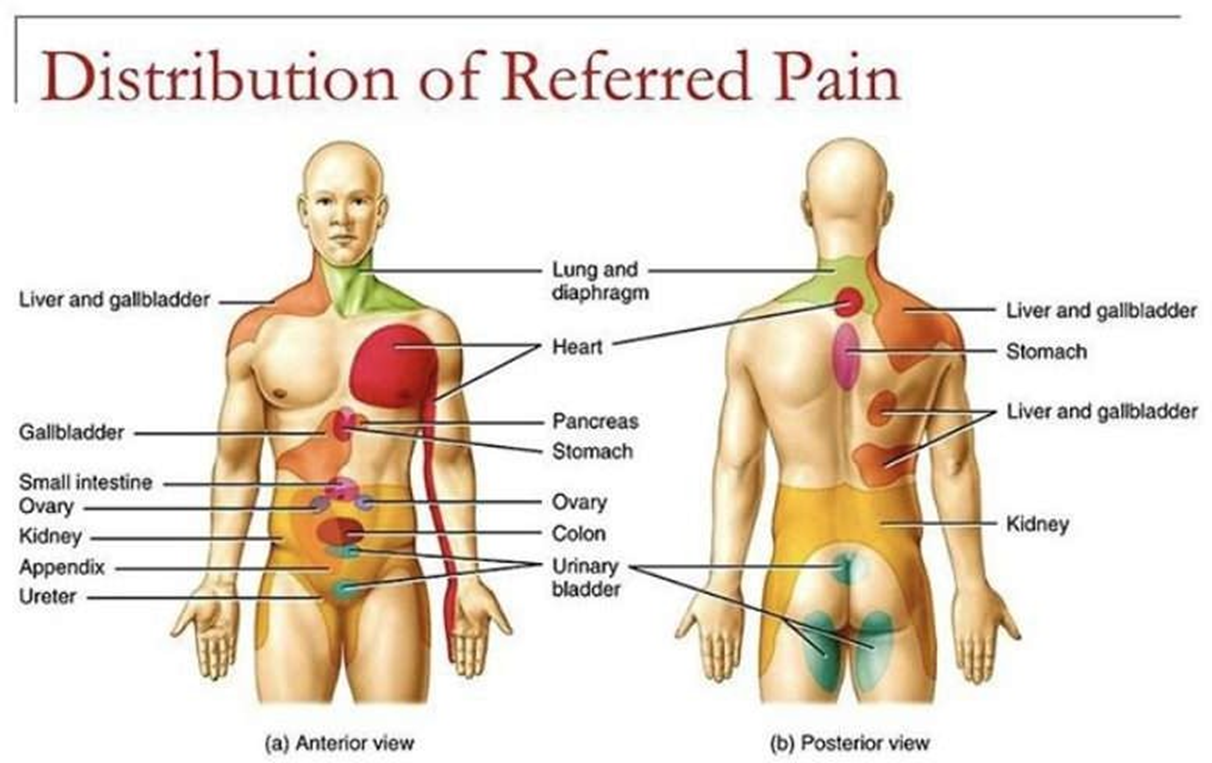A patient is admitted for pain in the arm and jaw. The patient is later diagnosed with angina.
What type of pain does the arm and jaw pain most likely represent?
Intractable
Phantom
Referred
Cramping
The Correct Answer is C
Choice A rationale:
Intractable pain is pain that is persistent and does not respond to usual pain management methods. While angina can be intractable in some cases, it does not typically manifest as pain in the arm and jaw. Moreover, the patient in this scenario has not yet undergone pain management efforts, so it's premature to classify the pain as intractable.
Choice B rationale:
Phantom pain is pain that is felt in a part of the body that has been amputated or is no longer there. The patient in this scenario has not experienced any amputations, so phantom pain is not a valid explanation for the arm and jaw pain.
Choice C rationale:
Referred pain is pain that is felt in a part of the body that is different from the source of the pain. This is the most likely explanation for the arm and jaw pain in this patient. The heart and the arm and jaw share nerve pathways, so pain signals from the heart can be misinterpreted by the brain as coming from these other areas. This is a common phenomenon in patients with angina.

Choice D rationale:
Cramping pain is a type of pain that is often described as a muscle tightening or squeezing sensation. It is not typically associated with angina. While angina can sometimes cause chest tightness, it's not characterized by cramping in the arm and jaw.
Nursing Test Bank
Naxlex Comprehensive Predictor Exams
Related Questions
Correct Answer is D
Explanation
The correct answer is Choice D: Cover the client's wound with a moist, sterile dressing.
Choice D rationale: In the case of a client with a bowel protrusion from an abdominal incision, the immediate priority is to protect the exposed bowel and minimize the risk of further damage or infection. Covering the wound with a moist, sterile dressing serves to maintain tissue viability, prevent dehydration, and provide a protective barrier against contamination. This intervention preserves the integrity of the exposed bowel while awaiting further medical or surgical management.
Choice A rationale: Checking the client's vital signs is an essential aspect of postoperative care and may be indicative of the client's overall status, but it is not the first action in the case of bowel evisceration. Immediate attention should be directed towards protecting the exposed bowel, with vital signs being monitored closely thereafter to ensure the client's stability.
Choice B rationale: Informing the client about the need for a return to surgery is an important step in the client's care, as it allows for informed consent and understanding of the situation. However, in this scenario, the priority is to address the immediate issue of bowel exposure and provide initial care to the compromised tissue. Once the exposed bowel is appropriately managed, the client should be informed about the potential need for further surgical intervention.
Choice C rationale: Positioning the client in a supine position with knees flexed may help reduce abdominal tension and minimize further protrusion, but it is not the immediate action to take when faced with bowel evisceration. The initial focus should be on protecting the exposed bowel through the application of a moist, sterile dressing, followed by measures to optimize the client's position and promote tissue integrity.
Correct Answer is C
Explanation
Choice A rationale:
Irrigating the tubing with sterile normal saline solution is not a routine part of closed-wound drainage system care.
It's usually only done if there's evidence of a blockage or infection, and only under the direction of a healthcare provider. Unnecessary irrigation could introduce bacteria into the system and increase the risk of infection.
It could also disrupt the delicate balance of fluids in the wound and delay healing.
Choice B rationale:
Replacing the drainage plug after releasing hand pressure on the device is not correct. The drainage plug should actually be replaced before releasing hand pressure.
This is to prevent air from entering the system, which could disrupt the vacuum and impair drainage.
Choice D rationale:
Emptying the reservoir once per day is not frequent enough.
The reservoir should be emptied whenever it becomes full, which could be more often than once a day, depending on the amount of drainage.
Allowing the reservoir to become too full could put pressure on the wound and impede healing.
Choice C rationale:
Fully re-collapsing the reservoir after emptying it is essential to maintain the vacuum that promotes drainage. If the reservoir is not fully re-collapsed, the vacuum will be lost, and drainage will slow or stop.
This could lead to fluid accumulation in the wound, which could increase the risk of infection and delay healing.
Whether you are a student looking to ace your exams or a practicing nurse seeking to enhance your expertise , our nursing education contents will empower you with the confidence and competence to make a difference in the lives of patients and become a respected leader in the healthcare field.
Visit Naxlex, invest in your future and unlock endless possibilities with our unparalleled nursing education contents today
Report Wrong Answer on the Current Question
Do you disagree with the answer? If yes, what is your expected answer? Explain.
Kindly be descriptive with the issue you are facing.
